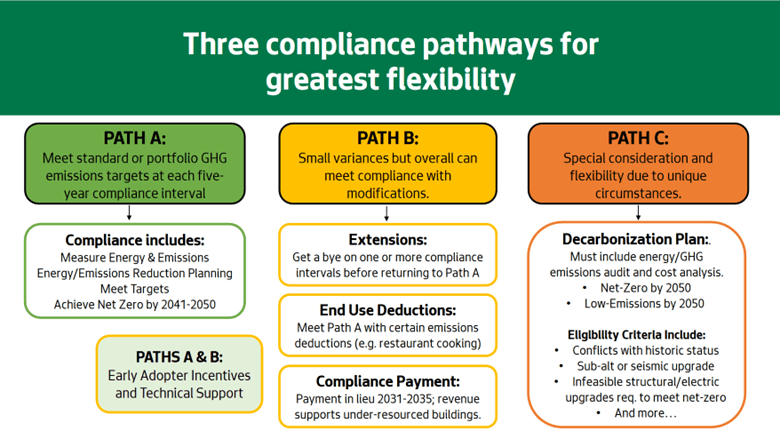If you own a large commercial or residential building in the city of Seattle, it is time to decarbonize your building or face the penalties imposed by a new city law. Seattle’s Building Emissions Performance Standard (BEPS), signed into law in December 2023, outlines compliance pathways and timelines for building owners to meet the city’s emissions reduction goals for existing buildings. The new law is intended to further the city’s climate action by reducing energy consumption and greenhouse gas (GHG) emissions in the building sector.
Our BEPS team is led by Michael Arndt, Jason Acosta, and Kyle Silliker.
The BEPS law establishes carbon emissions targets that existing buildings over 20,000 gross square feet (GSF) must meet over the next two to three decades. The Office of Sustainability & Environment is tasked with developing and implementing the BEPS for these buildings.
With the passage of BEPS, existing buildings in Seattle must now meet the requirements of both the city’s BEPS requirements and the state’s Clean Buildings Performance Standard (CBPS). Building owners must submit their compliance forms to separate city and state portal sites.
The BEPS legislative language can be daunting to navigate, but RDH’s team of professionals—including Qualified Energy Auditors, engineers, architects, and administrative staff—are available to guide you through each step of the process. This article provides a synopsis of the new law and the steps needed to reach compliance.
Benchmark Your Building
Before you can take action to reduce your building’s carbon emissions, you will need to determine the current performance of your building. The City of Seattle has required benchmarking of buildings greater than 20,000 GSF since 2015. Their public website, Seattle Benchmarking Map, shows building performance based on reporting by various building owners over the years. You can use this tool to judge where your building currently stands on compliance.
Meet the Deadlines
The timeline for BEPS compliance is shown in the graphic below. Compliance requirements for 90,000+ GSF buildings start in 2027, with buildings 50K to 90K GSF in 2028 and buildings 20K to 50K GSF in 2029. In each subsequent interval, buildings are required to meet progressively lower emissions targets.
***Image from the City of Seattle
The 2027 deadline is not that far away. Building owners need to show their normal consumption rates 12 months prior to the deadline, so it is best to get started early. If emissions reductions are required, building improvements must be completed 12 months prior to the deadline. Compliance requires verification and reporting. To meet these requirements, BEPS encourages owners to prepare, develop plans, and—if their building is not already below targets—start actions now to meet the 2031–2035 emissions targets.
By determining your building’s greenhouse gas intensity (GHGI) and greenhouse gas intensity target (GHGIT) now, you will better understand your building’s needs and how to budget for improvements that may be needed.
Stay Informed
To fill in gaps in the legislative language, final rulemaking is expected to take place over the summer and fall of 2024. This process will include public comment meetings. You can stay informed about rule changes by signing up for meeting notices here.
Follow these Basic Compliance Steps
RDH has developed these 6 steps to meet BEPS compliance:
- Monitor Your Energy Star Account
In the City of Seattle, the owners of buildings 20K GSF or larger have been required to benchmark their buildings for several years. Confirm that utilities are maintaining their data input to your Energy Star account. - Hire a Qualified Person
The City of Seattle has defined specific certifications to meet the “Qualified Person” role and what they need to perform. RDH has a team of “Qualified Persons” who can help you with BEPS compliance. Using the data from Energy Star, an RDH staff member can work on your behalf to calculate the GHGI of a covered building and determine if it meets the GHGIT. GHGI is calculated using the total building consumption of each energy fuel type multiplied by the fuel type’s emissions factor divided by the square footage of the building. The building emissions are measured using GHGI in kgCO2e/SF/year and are calculated with weather-normalized energy multiplied by the emissions factor for each energy source. - Determine the Best Compliance Pathway
The city created 3 basic compliance pathways, shown in the chart below, to identify what a building owner needs to do based on how well their building is performing. Pathway A is for buildings that meet their targets and are on the way to compliance. Pathways B and C are for buildings that do not yet meet their targets.
If your building does not meet compliance, RDH staff will advise you on which pathway aligns with your building’s needs.***Image from the City of Seattle
Residential condominium buildings require some special considerations that are different from other building types:
– Emissions from fossil fuel equipment (such as a gas stove) located within individual residential condominium units (all compliance intervals) are to be deducted.
– The building is considered “all-electric” when all space and water heating systems, and other equipment and appliances, under common ownership use only electric energy.The GHGITs for multi-use buildings are calculated based on a pro-rated mix of spaces and may also be normalized for hours of operation and multifamily occupancy density. These targets have been set but could be changed in the future regulatory cycle.
- Determine What Improvements Are Needed and When
Have a Qualified Person develop an Energy Plan for your building to help you better budget and plan for needed improvements so you won’t pay penalties. - Implement Improvements
RDH can prepare a scope of work and construction documents for implementing the improvements, so you are ready for bidding to help get the best pricing for the required improvements. - Re-Benchmark Your Building
After any improvements are made, wait 12 to 15 months, then RDH can re-benchmark your building to determine its current GHGI. Compare this result with the next cycle’s GHGIT requirement to determine next steps.
Support
The city has created a support team for free self-help to help guide you through this process. It is the Seattle Clean Buildings Accelerator. They provided a website to provide resources for all building owners. For specific groups they can provide Coaching and Training, like buildings serving or in Black, Indigenous, People of Color (BIPOC) and frontline communities.*
*Frontline communities include Black people, Indigenous people, sovereign tribal nations, communities of color, immigrants, refugees, youths, elders, houseless people, disabled people, LGBTQ+ people, people with low and no income, and people who work in outdoor occupations.
Incentives and Funding
Seattle City Light and Puget Sound Energy have various incentives/rebates to take advantage of along with funding from the City of Seattle. There is also the King County C-Pacer program available to support improvements to your building, along with many other sources. There is also the CBPS Early Adopter Incentive that can be used in conjunction with the BEPS requirements. The City of Seattle is exploring to have some type of Early Adopter Incentive as well. Lastly, there are tax incentives for energy improvements.
Consider an Exemption
The city may allow for some exemptions, but they are only for each 5-year cycle. If you want to explore an exemption, you will need to apply for it and get it approved, similar to the state’s CBPS process. Exemptions are limited to buildings with extremely low emissions due to their use of only electric energy, or if the building is scheduled to be demolished within 3 years of the compliance deadline as detailed in the Charter of The City of Seattle 22.925. Extensions are available as noted in Section 22.925.110 of the Seattle Municipal Code.
Avoid Penalties for Noncompliance
The city is encouraging strong compliance with BEPS through robust owner and tenant engagement.
Noncompliance will result in financial penalties. Flat fines of $15,000 and $7,500, depending on building size, may be imposed for owners who fail to report or submit inaccurate reports. For failure to meet GHGI targets (2031 and later), non-compliance carries penalties of $2.50/square foot for low-income housing/low-rent multifamily buildings, $7.50/square foot for other multifamily and $10.00/square foot for nonresidential buildings per 5-year cycle.
Along with this is the required compliance with the state’s Clean Buildings Performance Standard and its penalties.
Contact RDH for Help
RDH is equipped in numerous ways to guide building owners throughout this process. Besides having the personnel to fulfill the City of Seattle’s BEPS requirements, we can combine our compliance work with Washington State’s CBPS into one package. We also have several other specialists who have extensive experience with deep building energy retrofits.
RDH Seattle BEPS Team:

Senior Project Consultant

Principal, Senior Project Manager

Principal, Senior Building Science Specialist




